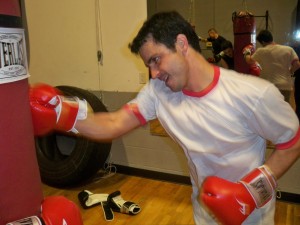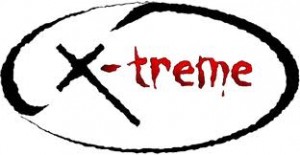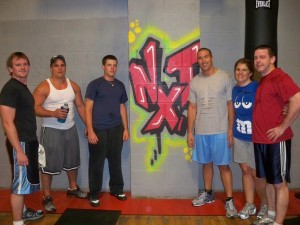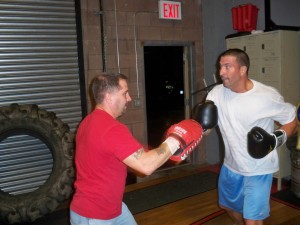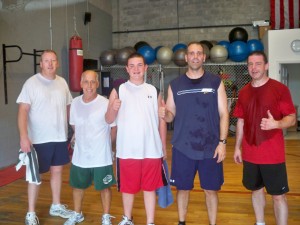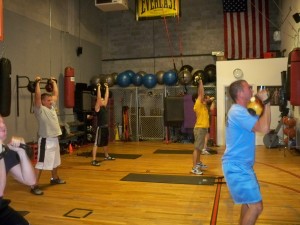ROD 110811
ROD
Tuesday, 08Nov11
Ready for Anything Training!!!!!
This class is a 1 hour ass kicking circuit that will leave you in a puddle of sweat.
Your cardiorespiratory and muscle strength will benefit from our motivational, challenging and fun circuit training set to energetic music.
Let’s see what you’ve got!!!!
___________________________________________________________________________
H.I.I.T.
We will put everything we’ve learned so far. We are staying on the Deadlifts, Hang Squat Cleans and Front Squats which will be reviewed to ensure movement accuracy and injury prevention. There will be No Gloves used or modification of the exercises. Mix your grips up so you can feel the differences on the bar. If you can only get 5 reps and you have to stop, then rest until you can continue the set. Thats what it’s all about. So that the next time we perform this ROD you will see and feel the improvements in both increased strength and decreased time. Please, Please!! make sure you post your time to comments. This is mandatory for this class. We need a reference we can come back to.
H.I.I.T. ROD
How many rounds can you do in 15 mins of:
7 Burpees
14 Hang Power Cleans (without the squat)
7 DB Push Press
________________________________________________________________________
A walk down memory lane…the early years
__________________________________________________________________________
Flag Football is here and most athletes will be sidelined with hamstring injuries.
Here are 5 Ways to Treat a Pulled Hamstring
1. Pulled Hamstring Defined
The hamstrings comprise the group of three muscles on the back of your thigh that function to bend your knee and straighten your hip. When you run, your hamstrings become fully stretched just before your foot hits the ground; this is when you’re most at risk of injury. If you pull a hamstring, you’ll know it, because you’ll feel a sudden, sharp pain or muscle spasm in the back of your leg. Swelling and bruising may appear later.
Where is Your Pain? In Three Steps We Can Identify The Cause And Recommend A Treatment. www.AtlanticSpinalCare.com
Sponsored Links 2. Recognize the Severity of a Hamstring Pull
Grade 1: Tightness in the back of your thigh and discomfort when walking, usually with minimal swelling, because only minor tears have occurred in the muscle.
Grade 2: Inability to fully straighten your knee, a limp when you try to walk and possibly some painful twinges occasionally with activity. Because the muscle is partially torn, you are more likely to have swelling, and you’ll feel pain when you press on the strained area.
Grade 3: Walking significantly impacted; severe pain, especially when bending your knee. You may need to use crutches. You’ll see immediate swelling, because the hamstring has been severely torn or completely ruptured. Grade 3 hamstring injuries are rare.
You can usually treat a Grade 1 hamstring injury at home. For a Grade 2 tear, a physical therapist can design an exercise program to help with your recovery. If you suspect a Grade 3 tear, see your physician, as you may need a surgical repair.
3. Start Treatment Right Away
No matter which category of strain you experience, start treatment immediately. Remember the mnemonic PRICE–Protection, Rest, Ice, Compression, Elevation. Prop your feet up and keep an ice pack on the spot where you feel the pain for 15 to 20 minutes several times each day for at least the first 48 to 72 hours. Use a lightweight compression bandage, but be careful that it’s not too tight. If it’s painful to walk, use crutches. Rest your leg frequently, but don’t cut out all activity. Keeping moving can be helpful. If your pain and swelling don’t improve, call your doctor.
4. Move On to Rehab
Begin gentle hamstring and calf muscle stretching exercises immediately, as long as they don’t increase your pain. It’s not uncommon to get immediate relief followed by an increase in pain. This should go away after you repeat the stretching exercises. As your pain and swelling decreases, slowly add strengthening exercises to your program. To avoid a chronic problem, be sure to complete your rehab. Give your hamstring the chance for a full recovery before resuming the activity that caused the damage in the first place.
5. Prevent Future Pulled Hamstrings
Age, fatigue, nerve impingement in the lower lumbar spine and lack of flexibility are all contributing factors to hamstring pulls. You can’t change your age, but you can get adequate rest, and maintain good strength and flexibility. This is especially important if you’ve already injured your hamstring, as it will be more prone to future injuries

